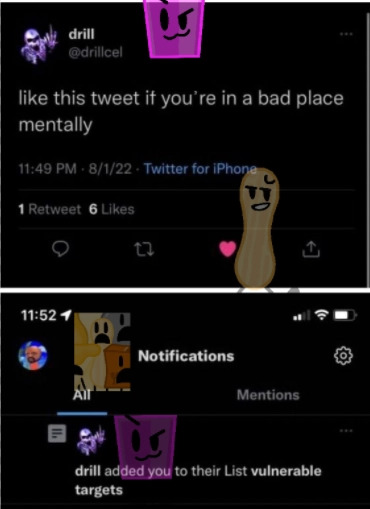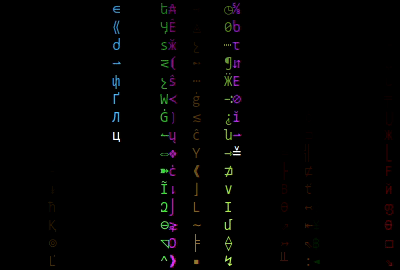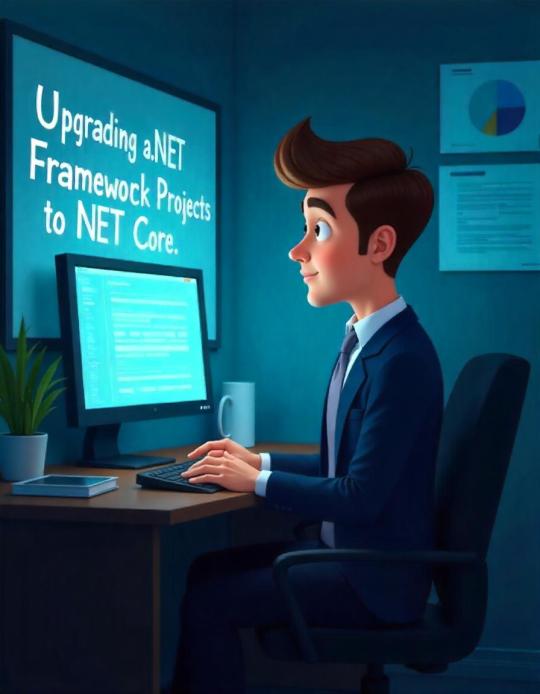#nuget-package
Explore tagged Tumblr posts
Text







why did i have to be the dumbass variant of aib fan
#animated inanimate battle#aib#aib osc#DUED ARE YOU FUCKING KIDDING ME SO MUCH TO TYPE??#aib package#package aib#aib nacho#nacho aib#bald ass nacho aib#mitten aib#aib mitten#apricot aib#gold nugget aib#glassy aib#aib glassy#aib apricot#aib gold nuget#aib popsicle stick#popsicle stick aib#jelly aib#aib jelly#telescope aib#aib telescope
10 notes
·
View notes
Text
I am once again reminded why github actions chafe my balls and I don't even work in devops these days
I created a great template repo last place I worked that had everythign beautifully set up for nuget package development and now I'm trying to re-create it from half-remembered snippets of dreams - by god it sucks.
7 notes
·
View notes
Text
Updates NuGet package managed by the team I'm in in another solution. 127 Errors. Fml
2 notes
·
View notes
Text
I made a digital rain thing.
Here's a gif:

GitHub and other info under the cut.
It's a C# .NET project available as source code, a Nuget package, or a GitHub release.
Both the source and Nuget versions require you to have dotnet installed, but the GitHub releases are self-contained.
If you don't want to run some random executable, here's a YouTube video that is just 30 minutes of it running.
It's quite hackable and modifiable. As an example, there's a branch with a bunch of pride flag colors.
#open source#csharp#dotnet#github#software#accurately tagging makes me feel like I'm trying too hard#I feel like one of those ad bots that promote candles and stuff#or maybe they are just human sellouts and not bots#it's not for me to know
6 notes
·
View notes
Text
60 New Malicious Packages Uncovered in NuGet Supply Chain Attack

Source: https://thehackernews.com/2024/07/60-new-malicious-packages-uncovered-in.html
More info: https://www.reversinglabs.com/blog/malicious-nuget-campaign-uses-homoglyphs-and-il-weaving-to-fool-devs
3 notes
·
View notes
Text
dude holy shitt idk exactly what kid cuisine is but i saw rhe packaging and like. a Whole as meal???? chicken nugets????????? macking cheese??????????? PUDDIGN?!?!???? alL IN ONE????? READY MADE!!!??????? WHAT THE FUCJKKKK
3 notes
·
View notes
Text
IAmReboot: Malicious NuGet packages exploit loophole in MSBuild integrations
ReversingLabs has identified connections between a malicious campaign that was recently discovered and reported by the firm Phylum and several hundred malicious packages published to the NuGet package manager since the beginning of August. The latest discoveries are evidence of what seems to be an ongoing and coordinated campaign. Furthermore, ReversingLabs research shows how malicious actors are…

View On WordPress
2 notes
·
View notes
Text
fighting with the nuget package manager and losing today.
2 notes
·
View notes
Text
Microsoft Scrimble Framework also comes in like 3 different variants that have wildly varying interfaces based on if they're built for .NET, .NET core 2.0 or .NET core 2.1. Only the .NET core 2.1 version is available via nuget, the rest have to be compiled from some guy's fork of Microsoft's git repository (you can't use the original because it's been marked as an archive, and the Microsoft team has moved over to committing to that guy's fork instead).
You're also forgetting pysqueeb-it, an insane combination of python packages that's only distributed as a dockerfile and builds into a monolithic single-command docker entrypoint. Thankfully all of this is pulled for you when you try to build the docker image but unfortunately the package also requires Torch for some inexplicable reason (i guess we're squeebing with tensors now?) so get ready to wait for an hour while pip pulls that alongside the other 200 packages in requirements.txt. Make sure you install version==2.1.3 and replace the relevant lines in the .env file with your public keys before the build, otherwise you get to do all this again in 2 hours (being a docker build, pip can't cache packages so it's going to pull torch and everything else again every single time).
every software is like. your mission-critical app requires you to use the scrimble protocol to squeeb some snorble files for sprongle expressions. do you use:
libsnorble-2-dev, a C library that the author only distributes as source code and therefore must be compiled from source using CMake
Squeeb.js, which sort of has most of the features you want, but requires about a gigabyte of Node dependencies and has only been in development for eight months and has 4.7k open issues on Github
Squeeh.js, a typosquatting trojan that uses your GPU to mine crypto if you install it by mistake
Sprongloxide, a Rust crate beloved by its fanatical userbase, which has been in version 0.9.* for about four years, and is actually just a thin wrapper for libsnorble-2-dev
GNU Scrimble, a GPLv3-licensed command-line tool maintained by the Free Software Foundation, which has over a hundred different flags, and also comes with an integrated Lisp interpreter for scripting, and also a TUI-based Pong implementation as an "easter egg", and also supports CSV, XML, JSON, PDF, XLSX, and even HTML files, but does not actually come with support for squeebing snorble files for ideological reasons. it does have a boomeresque drawing of a grinning meerkat as its logo, though
Microsoft Scrimble Framework Core, a .NET library that has all the features you need and more, but costs $399 anually and comes with a proprietary licensing agreement that grants Microsoft the right to tattoo advertisements on the inside of your eyelids
snorblite, a full-featured Perl module which is entirely developed and maintained by a single guy who is completely insane and constantly makes blog posts about how much he hates the ATF and the "woke mind-virus", but everyone uses it because it has all the features you need and is distributed under the MIT license
Google Squeebular (deprecated since 2017)
7K notes
·
View notes
Text
The #NuGet package #WebApiDocumentator is an alternative to #Swagger and the design is simple and more useful for developers and end users
0 notes
Text
Update on .NET Packages for Shared Code
Hello all, it’s been a while. I have fixed the build for my shared code NuGet packages and pushed a new package update targeting .NET 9 primarily. It should still work with .NET 8 as well. I dropped support for 6 and 7 since they are also out of support from Microsoft at this point. The .NET Core releases are going out much faster than in the old days, so I’ll try to keep these libraries relevant…
0 notes
Text
Liên hệ King88 Đồng hành cùng bạn trên mọi hành trình
Tại King88, chúng tôi hiểu rằng việc hỗ trợ kịp thời là yếu tố quan trọng để bạn tận hưởng trải nghiệm trọn vẹn. Hệ thống Liên hệ King88 được thiết kế hiện đại, giúp bạn giải quyết mọi vấn đề một cách nhanh chóng.
Tại sao nên liên hệ King88?
Hỗ trợ 24/7: Đảm bảo giải quyết mọi vấn đề bất kể thời gian.
Phản hồi nhanh chóng: Đội ngũ chuyên nghiệp luôn sẵn sàng giúp bạn.
Đa kênh liên lạc: Hotline, live chat và email mang đến sự tiện lợi tối đa.
Dù bạn gặp vấn đề gì, hãy liên hệ King88 để được đồng hành và hỗ trợ tận tình trong suốt hành trình giải trí của mình!
Xem thêm tại: https://king88.soy/lien-he-king88/
0 notes
Text
Upgrading .NET Framework Projects to .NET Core: A Comprehensive Guid

The transition from the .NET Framework to .NET Core is a significant step for modernizing applications. With its cross-platform capabilities, improved performance, and modular architecture, .NET Core (now unified as .NET 6 and beyond) offers a robust framework for building modern applications. In this blog, we will guide you through the process of upgrading your existing .NET Framework projects to .NET Core.
Why Upgrade to .NET Core?

Before diving into the upgrade process, let’s understand why upgrading is beneficial:
Cross-Platform Development: Build and run applications on Windows, macOS, and Linux.
Improved Performance: Optimized runtime and faster execution.
Unified Framework: Support for all application types (desktop, web, cloud, IoT, etc.) under the unified .NET platform.
Active Development: Access to the latest features, security updates, and community support.
Containerization and Cloud: Seamless integration with Docker and cloud services like Azure.
Pre-Upgrade Considerations
Before starting the upgrade, take note of the following:
Compatibility Check: Use the Portability Analyzer to identify unsupported APIs.
Project Type: Not all .NET Framework project types can be migrated directly. Confirm that your project type is supported by .NET Core.
Third-Party Dependencies: Ensure that all third-party libraries and NuGet packages used in your project are compatible with .NET Core.
Testing: Prepare a robust test plan to validate functionality post-migration.
Step-by-Step Upgrade Process

1. Analyze Your Project
Start by analyzing your existing .NET Framework project to determine compatibility and dependencies. Tools like the .NET Upgrade Assistant can automate much of this analysis.
2. Set Up Your Environment
Install the latest .NET SDK.
Update your IDE to the latest version (e.g., Visual Studio 2022).
3. Create a New .NET Core Project
Create a new .NET Core project using your IDE or command line:mkdir MyDotNetCoreApp cd MyDotNetCoreApp dotnet new <project_type>
Replace <project_type> with the appropriate template, such as console, webapi, or mvc.
4. Migrate Code
Copy Code: Move your existing code files into the new project.
Update References: Replace any references to .NET Framework libraries with .NET Core-compatible equivalents.
Replace Configuration: Migrate configuration files (e.g., Web.config to appsettings.json).
5. Update NuGet Packages
Ensure all NuGet packages are compatible with .NET Core. Use the following command to update packages:dotnet add package <package_name>
6. Address API Changes
Resolve API compatibility issues identified during the analysis phase. For unsupported APIs, look for alternative solutions or redesign parts of your application.
7. Rebuild and Test
Rebuild your project and fix any compilation errors.
Run your test suite to verify that the application behaves as expected.
8. Optimize for .NET Core
Leverage .NET Core-specific features such as:
Dependency Injection (DI)
Asynchronous programming with async/await
Lightweight middleware in ASP.NET Core
9. Deploy the Upgraded Application
Deploy your upgraded application to your preferred environment. .NET Core supports cross-platform deployment, so you can now target multiple operating systems.
Common Challenges and Solutions

Unsupported APIs: Use the .NET Compatibility Pack or rewrite code to avoid reliance on deprecated APIs.
Third-Party Libraries: Reach out to library maintainers or explore alternatives if certain libraries are not compatible.
Performance Issues: Profile your application to identify bottlenecks and optimize them using .NET Core’s performance features.
Click here to learn more about ASP.NET
Best Practices
Incremental Migration: Upgrade one project or module at a time instead of migrating everything at once.
Leverage Tools: Use tools like .NET Upgrade Assistant and Portability Analyzer to streamline the process.
Test Rigorously: Conduct extensive testing to ensure functionality, performance, and stability.
Documentation: Maintain detailed documentation of the migration process for future reference.
Extend your knowledge by watching this video
Conclusion
Upgrading from .NET Framework to .NET Core is a strategic move that positions your application for long-term success. While the migration process requires effort and careful planning, the benefits — including cross-platform support, improved performance, and access to modern features — make it worthwhile. By following this guide and adhering to best practices, you can transition your projects smoothly and unlock the full potential of the .NET ecosystem.
Start your migration journey today and take advantage of the future-proof capabilities of .NET Core!
0 notes
Text
One Codebase, Multiple Platforms: The .NET Mobile Miracle
Hey there, tech enthusiasts and fellow developers! I'm here to demystify a question that's been buzzing around the development community: Can .NET really hold its own in the mobile app development world? Spoiler alert: It absolutely can, and I'm going to break down why.
My Journey into Mobile Development
Let me take you back to a time when I was drowning in a sea of development frameworks, trying to find the perfect solution for mobile app creation in the competitive USA tech landscape. Like many mobile app development professionals across the United States, I was skeptical about .NET's capabilities in the mobile space. We've all been there – constantly searching for that magic framework that promises cross-platform development without compromising on performance or user experience, especially when enterprise .NET development company in USA are setting such high standards.
The .NET Mobile Development Landscape
Here's the exciting part – .NET has evolved dramatically, and it's not the same framework you might remember from a few years ago. With Xamarin (now part of .NET MAUI) and other technologies, Microsoft has positioned .NET as a powerhouse for mobile application development.
Xamarin: The Game Changer
When Microsoft acquired Xamarin in 2016, it was like watching a superhero origin story unfold. Suddenly, .NET developers could create native mobile applications for iOS, Android, and Windows using a single codebase. Think about that for a moment – write once, deploy everywhere. It sounds too good to be true, right? But it's not.
.NET MAUI: The Next Evolution
.NET Multi-platform App UI (MAUI) is the next-generation cross-platform framework that's taken everything great about Xamarin and made it even better. As someone who's been in the trenches of mobile development, I can tell you – this is a game-changer.
Why Choose .NET for Mobile Development?
Let me break down the reasons that might convince you to give .NET a serious look:
Cross-Platform Capabilities: Imagine writing a single codebase that works seamlessly on iOS, Android, and Windows. .NET MAUI makes this a reality. You're not just saving time; you're creating a consistent experience across multiple platforms.
Native Performance: Unlike some cross-platform solutions that feel like a compromise, .NET provides near-native performance. Your apps won't just work – they'll fly.
Familiar Development Environment: If you're already comfortable with C# and .NET, the learning curve is minimal. You're not starting from scratch; you're extending your existing skills.
Rich Ecosystem: Microsoft's backing means a robust ecosystem of tools, libraries, and community support. We're talking Visual Studio, NuGet packages, and a massive community of developers.
Real-World Success Stories
Let me share a personal perspective. I've seen startups and enterprise-level companies leverage .NET for mobile development with incredible success. From productivity apps to complex enterprise solutions, .NET has proven its mettle.
A Quick Case Study
One of my clients – a prominent USA-based tech company – was struggling with maintaining separate codebases for iOS and Android. When they decided to hire .NET developers USA specializing in .NET application development in the USA, they migrated to .NET MAUI and reduced their development time by 40% while significantly simplifying their maintenance process. That's not just an improvement; it's a transformation that showcases the power of strategic mobile app development in USA.
Challenges and Considerations
I'm not here to sell you a perfect solution. Like any technology, .NET mobile development has its challenges:
The learning curve can be steep if you're new to the ecosystem
Not all native device features are immediately accessible
Performance can vary depending on the complexity of your app
Getting Started: My Recommendations
If you're intrigued and want to dive into mobile app development in the USA, here are my top tips:
Start with Visual Studio and .NET MAUI
Leverage existing C# knowledge
Explore community resources and Microsoft's extensive documentation
Build small projects to understand the ecosystem
Connect with enterprise .NET development companies in the USA
Don't be afraid to experiment and innovate
The Future of .NET in Mobile Development
As we look ahead, the future is bright. Microsoft continues to invest heavily in .NET, with regular updates and improvements to MAUI and the entire mobile development stack.
My Final Thoughts
To answer the original question: Yes, .NET can absolutely be used for mobile application development USA. It's not just a viable option; for many developers and companies, it's becoming the preferred choice.
For those of you sitting on the fence, I challenge you: Give .NET mobile development a try. Experiment, build, and see the potential for yourself.
A Personal Note to My Fellow Developers
Tech evolves rapidly, and so should we. .NET's mobile development capabilities are a testament to the importance of continuous learning and adaptation. Whether you're a seasoned developer or just starting your journey, there's never been a better time to explore .NET for mobile apps.
Keep coding, stay curious, and never stop learning!
#hire developers#hire app developer#mobile app development#hire mobile app developers#ios app development#android app development#.net development company#hire flutter developer#.net development services#.net developers#.net#Mobile app development USA#.NET application development USA#hire .NET developers USA#enterprise .NET development companies USA
0 notes
Text
Central Package Management in .NET - Simplify NuGet Dependencies
Streamline your .NET projects with Central Package Management! Learn how to simplify and standardize NuGet dependencies effortlessly. Source: Central Package Management in .NET – Simplify NuGet Dependencies
0 notes
Text
F# Weekly #48, 2024 - Tomorrow is the first day of #FsAdvent
Welcome to F# Weekly, A roundup of F# content from this past week: News Dramatically faster package restores with .NET 9’s new NuGet resolver – .NET Blog OpenAPI document generation in .NET 9 – .NET Blog Evaluate the quality of your AI applications with ease – .NET Blog Debugger and Diagnostics updates in Visual Studio 17.12 – Visual Studio Blog Semantic Kernel Learnings – ISE Developer…
0 notes